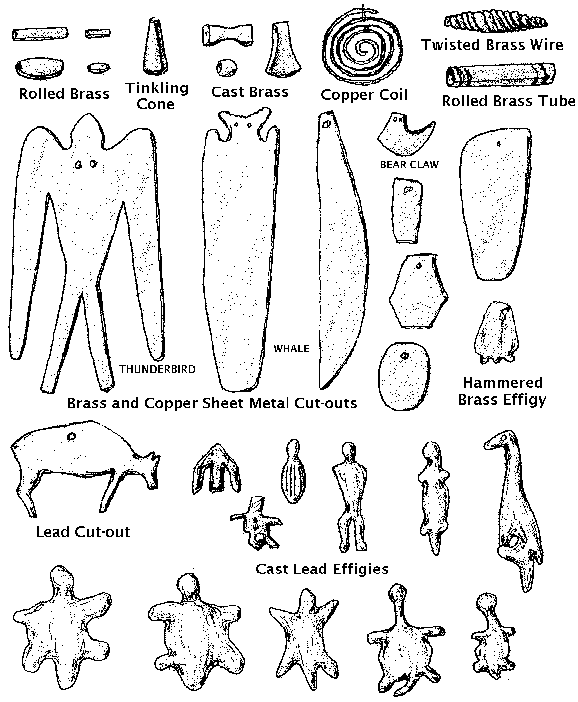 |
Early Native American metal work in New England includes the manufacture of copper and brass ornaments, as well as wire inlay and lead casting to make beads and pendants. Most copper used along the east coast at the time of contact was European in origin, excepting some rare items made of native copper. Native copper of the northeast is found in the Lake Superior region and Nova Scotia. Native Americans of northern New England occasionally used indigenous copper to make beads, frequently small spheres of metal. These beads were made from copper nuggets, repeatedly hammered flat and rolled into shape. The limited use of native copper in the New World did not hinder Native American metal work once European trade copper and sheet brass reached the coast during the 1500’s. Manufacturing techniques of later brass beads and pendants suggest an aboriginal acquaintance with working native copper.
Although some metal beads were produced and traded by Europeans, many other copper and brass ornaments were worked up from broken kettles. When metal vessels became too worn for use as a container, the metal was often cut-up, and recycled into other items, including beads and pendants. The Seneca and other Native Americans wore rolled tubular and tapering oval-shaped brass beads. Native Americans of New York bent strips of copper sheet, probably supplied by Europeans, into tubes and often used the beads in headbands with shell beads. Copper beads and earrings were also made of wire, hammered flat and twisted into a spiral. Tubular brass beads of native manufacture were wrapped around reeds or sticks of wood with spongy centers. European-manufactured brass beads had no core and were likely wound around metal mandrels.
Among Native Americans in the 1600’s, metal pendants imitating teeth, claws, or effigies may have become popular as authentic beads of teeth or bone became unavailable, because the animals were not easily hunted. Native American men across the northeast wore huge breastplates, which hung from the neck, of flattened sheets of copper or brass which often measured a foot long and six inches wide. Such large pendants of sheet metal include a copper ‘thunderbird’ design gorget from New Hampshire, and Wampanoag sheet brass pendants representing fish or whale effigies. Smaller pendant shapes in sheet metal include triangles and roughed out rectangles and plain perforated brass disks that were slightly domed and probably attached to clothing. Other Native American copper or brass ornaments (sometimes European-made for tobacco or tinder) were small boxes or rattles containing strung wampum or tiny quartz pebbles.
 |

© 1994-1999 Tara Prindle.